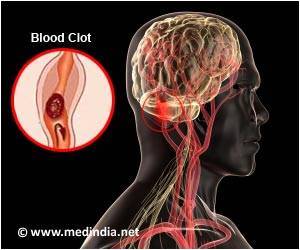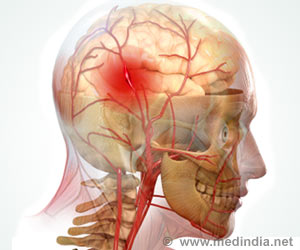- A draft NHS policy on mechanical thrombectomy as treatment recommends that the facility be made available round the clock in specialty centers across the country.
- Mechanical thrombectomy is safe and effective for large vessel occlusion strokes than previously used intravenous thrombolytic drugs.
- For maximum benefit of mechanical thrombectomy, patients have to be brought into the centers within six hours of onset of stroke.
Mechanical thrombectomy is a treatment that can potentially reverse the devastating effects of a stroke. It can remove blood clots from the blood vessels of the brain in acute stroke patients. It thus restores blood flow and prevents or limits the damage that can be caused by a stroke. Mechanical thrombectomy devices are being used for clot removal in selected patients in the United States and Europe.
Facts on Stroke
Stroke occurs when blood flow to a particular area of the brain is cut off. As a result, brain cells are deprived of oxygen and start to die.Abilities that are affected by that particular brain region start deteriorating; examples are loss of memory and muscle control.
The location and severity of stroke will determine how a person gets affected.
Small strokes may result only in temporary weakness of an arm or leg while larger strokes can cause permanent paralysis on one side of the body or speech disabilities.
There are 2 types of strokes -
- Hemorrhagic - When a weakened blood vessel leaks and blood spills into or around the brain. There is inflammation and pressure build-up, and the brain cells and tissues are damaged. It is the less common but more fatal kind of stroke.
- Ischemic - When a blood vessel that carries blood to the brain gets blocked by a blood clot. Hence, blood does not reach the brain. About 87% of strokes are ischemic in nature.
When the blood clot (embolus) forms in the heart or somewhere else in the body and travels up to the brain, it is an embolic stroke. On reaching the brain, if the clot gets lodged in a small blood vessel, it can block it completely causing the stroke.
An acute ischemic stroke is caused by a large vessel occlusion; in other words it is caused by thrombotic or embolic occlusion of an artery or blood vessel supplying blood to the brain.
Statistics on Stroke
According to World Health Organization (WHO) in 2014, stroke causes 6.7 million deaths every year worldwide making it the second most common cause of death in the world.Burden of disease that includes disability, illness and premature death due to stroke is projected to double by 2030.
Around 152,000 patients suffer from strokes every year in the United Kingdom.
Mechanism of Mechanical Thrombectomy Devices
Mechanical thrombectomy is a endovascular technique to treat diseases that occur inside blood vessels. This technique stem from interventional radiology techniques that use minimally invasive image-guided diagnosis and treatment of diseases in the organs.Endovascular techniques have become a preferred and alternative method since they use only needles and narrow tubes called catheters that are inserted into the body instead of making large incisions like in traditional surgeries.
In mechanical thrombectomy, the patient is put under general anesthesia or local anesthesia. A long, thin tube called a catheter is inserted via an artery (large blood vessel) in the groin. The clot is located with the help of a cerebral angiography that uses contrasts and x-rays to view the blood flow in the neck and brain regions.
The catheter is then sent up to the location of the clot. A clot retrieval device like a wire or a coil is delivered through the catheter up to the location of the clot and is positioned near the side or across the target clot. The retrieval device re-assumes its native coil form when extruded from the catheter. The loops of the coil or wire are deployed through the clot so as to entangle it or physically break it; the coil and clot / clot pieces are then pulled back into the catheter.
Mechanical thrombectomy is a step ahead in endovascular therapy by bringing along added benefits of removing clots to enable revascularization (restoring blood flow to a body part or organ that has been oxygen deprived) of cerebral vessels.
Professor Tony Rudd who is the national clinical director for stroke at NHS England said, “NHS stroke care and stroke survival are now at record levels. We recognize the potential effectiveness mechanical thrombectomy could have for about 10% of stroke patients and are drawing up a policy for its possible use across the NHS”.
Mechanical Thrombectomy is most effective -
- When used within six to eight hours of onset of acute symptoms
- In patients with large vessel occlusions when the clots are of cardiac or arterial origin
- In narrowed oxygen-depleted (ischemic) vessels rather than completely blocked (infarcted) vessels
Benefits of Mechanical Thrombectomy
- Can cure the most severe blood clots that cannot always be broken down by previously used thrombolytic drugs.
- Can bring patients “back to life” who would have otherwise had the worst outcome.
- Can save millions of pounds or dollars by treating patients who might otherwise require a rehabilitation program or lead a life of severe disability.
- Can increase the percentage of people who can function independently 90 days after a stroke by between 19% and 35%.
References:
- Raychev R, Saver JL. Mechanical thrombectomy devices for treatment of stroke. Neurology Clinical Practice. 2012;2(3):231-235. doi:10.1212/CPJ.0b013e31826af206.
- National Stroke Association - (http://www.stroke.org/)
- Interventional radiology - (https://en.wikipedia.org/wiki/Interventional_radiology)
- Endovascular Treatment of Acute Ischemic Stroke - (http://www.cpmc.org/advanced/neurosciences/bulletin/2013/cpni-bulletin-2013-ais-stroke.html)















